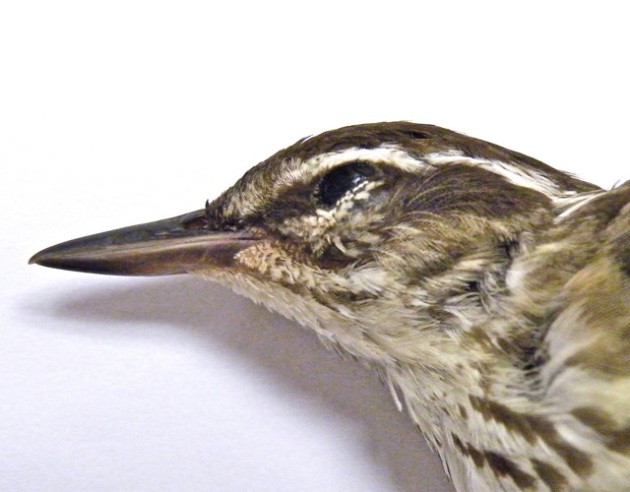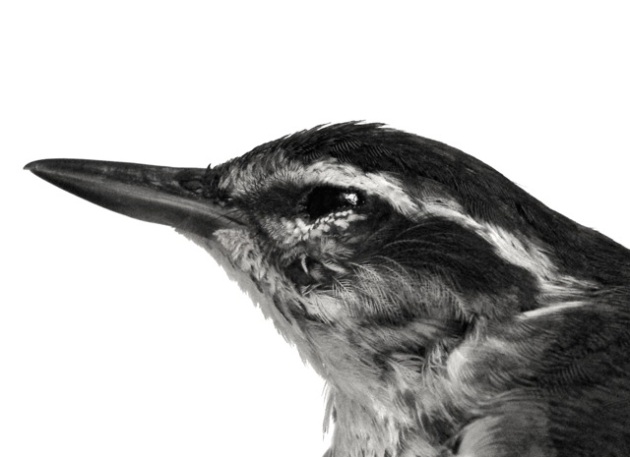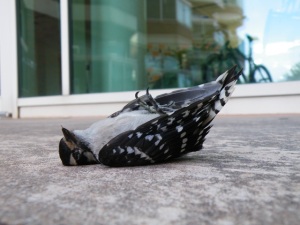Monthly Archives: June 2014
29 June 2014 – no casualties
28 June 2014 – no casualties
27 June 2014 – no casualties
26 June 2014 – Carolina Chickadee
25 June 2014 – no casualties
Mourning Dove remains remain.
24 June 2014 – no casualties
23 June 2014 – no casualties
22 June 2014 – no casualties
21 June 2014 – no casualties
20 June 2014 – no casualties
19 June 2014 – Louisiana Waterthrush
Okay, now it’s personal.
Here in my 21st year of monitoring buildings for window-killed birds, I have finally come across a Louisiana Waterthrush. Folks who know me well will instantly recognize the special place this species holds in my life as the Pinnacle of Avian Evolution. Here’s a presentation of mine that discusses waterthrushes as the focus of indicators of watershed condition:
Here’s a basic distribution map from the National Audubon Society’s Online Guide to North American Birds:
Among the many cool attributes of these remarkable birds, Louisiana Waterthrush is one of the earliest Nearctic-Neotropical migrants to arrive on the breeding grounds in spring. I have observed these birds on breeding territories during a snow squall in Pennsylvania. They come back early, weeks before the big wave of other migrant warblers, breed early, and by the end of June become quite scarce. Presumably, they seek sheltered locations for their annual molt for several weeks in late June and July, but by mid-July, many are well on their way south for the winter. It is quite rare to see a waterthrush in fall migration, in part because they go so early but also because, unlike their close relative Northern Waterthrush, Louisianas so rarely are found outside a riparian zone. Whereas Northerns will move with other flocks of warblers and can easily be found on migration at upland sites – including your backyard – Louisianas tend to really stick to the waterways, and they go it alone. The fact that this bird ended up at an upland site, in June, is quite unusual.
Here is today’s victim, bedraggled and rain-splattered from a quick cloudburst this morning, and where she met her end:
She was an ASY (after second-year) female with a brood patch. She had no fat laid down. It’s tough to tell if she was literally on her fall migration or just wandering around in a bit of post-breeding dispersal, but there certainly isn’t anything that remotely qualifies as “waterthrush habitat” in the vicinity of the Noble Research Center. She also had not begun a pre-basic molt, which indicates that she’s probably not migrating yet.
This is the second consecutive day in which a new species was added to the study (49 now).
18 June 2014 – Downy Woodpecker
17 June 2014 – trapped Carolina Wren (again?)
I found this morning what looked very much like the same Carolina Wren as on June 15, trapped at the “bunting door” on the south side of the NRC. Again, the bird was panting but when I picked it up it screamed and when released it flew strongly away. I guess I need to start banding these trapped birds. (Mourning Dove carcass from 6/10 remains evident.)
16 June 2014 – no casualties
15 June 2014 – trapped Carolina Wren
On this Father’s Day 2014, I was surprised to find a mother Carolina Wren trapped at the NRC. This is a common species in Stillwater, of course, but rarely seen on campus. In 5 years, I’ve found one dead and had two trapped.
This bird was in a shallow corner by the main north entrance. She was tired – panting – but I think she was just exhausted rather than injured. Certainly when I took hold of her (sexed by brood patch, btw), she screamed incessantly, drawing the attention of every robin, mockingbird, and starling within about 200 m. Here’s how I first found her:
Her disposition certainly illustrates that it doesn’t take much “depth” to trap a bird.
This is right before I grabbed her (the first time):
So I carried her away from the corner and to some trees in the courtyard. I figured it was an open enough vista to the north that she’d either take off away from the NRC immediately, or at least perch for a while first in the trees. Nope. She flew directly back across my left shoulder to end up here:
Now that was a first for me!
Okay, no more fooling around. I next picked her up and took her well away from the NRC, over near Cordell Hall. From there she flew strongly away from me and perched in a tree amid some scolding robins.
Humor at her predicament aside, this is a bird that would probably have died today – from exhaustion or predation in her vulnerable state – had I not been there poking around.
Update – 14 June 2014
Regular readers (are there any?) will note my absence over the past couple of weeks. I was on the road, in part to deliver a presentation on this research to the joint annual meeting of the Wilson Ornithological Society and the Association of Field Ornithologists. I was very lucky to have Dr. Scott Loss keep an eye on the Noble Research Center for me. He reported something new: a pair of trapped Scissor-tailed Flycatchers on June 1st. This is a new species for the study, despite the abundance of scissortails here in Stillwater. (Both were shooed away from the building and flew off strongly.) Scott also found a recently fledged Mourning Dove dead at the northwestern alcove on June 2nd.
On my return, I found a scavenged carcass of an adult Mourning Dove at the north entrance on Wed., June 11. I have conservatively recorded that bird as having died on the previous day (6/10), and its remains were still in evidence this morning. That’s it, you are now up to date with Avian Window Kills.



















